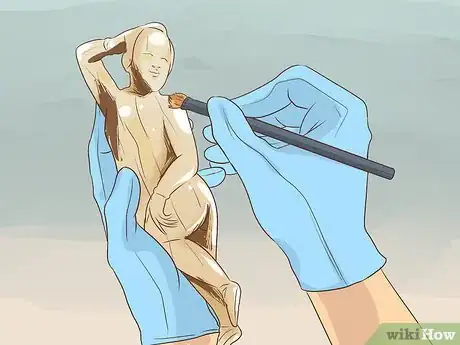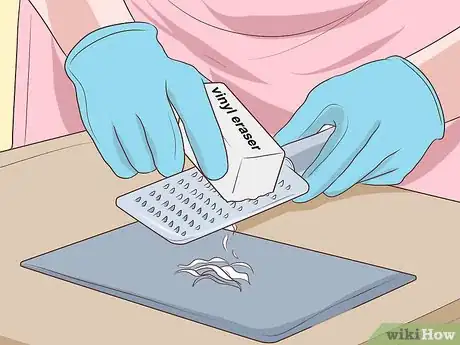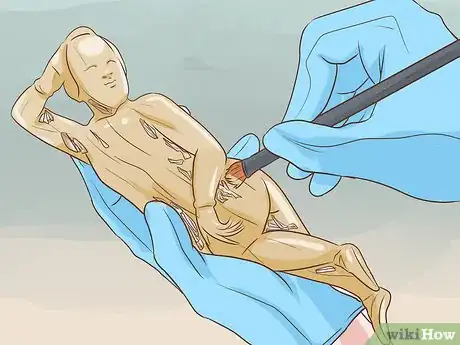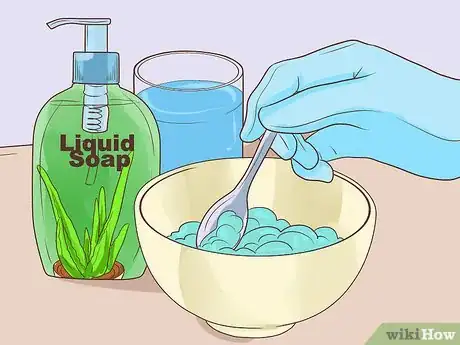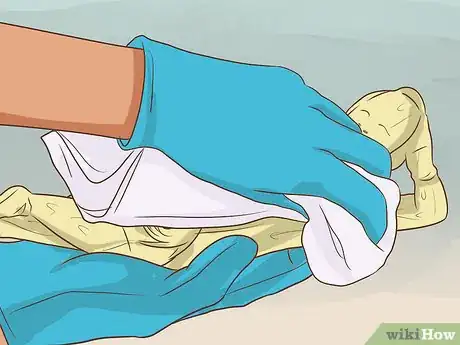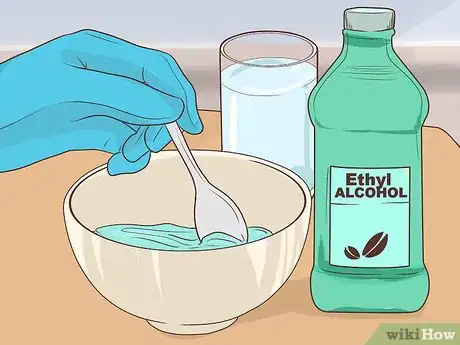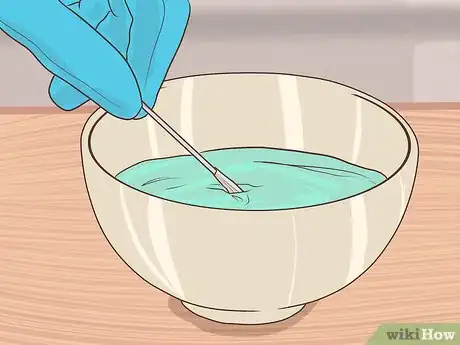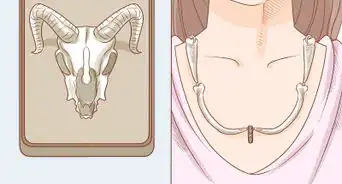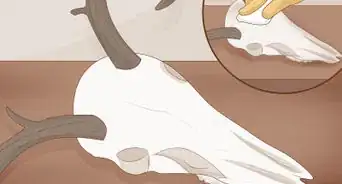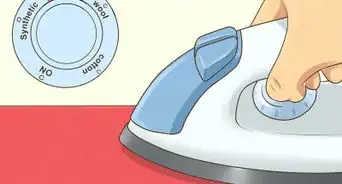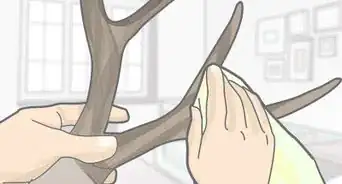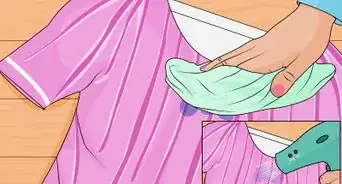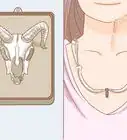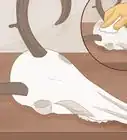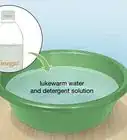This article was co-authored by Eduardo Peralta. Eduardo Peralta is a House Cleaning Specialist and the Manager of Best Maid House Cleaning based in San Jose, California. With over five years of experience, Eduardo and the Best Maid House Cleaning team specialize in home deep-cleaning, post-construction cleaning, and green and eco-friendly cleaning services. Best Maid House Cleaning is fully licensed and insured.
wikiHow marks an article as reader-approved once it receives enough positive feedback. In this case, 87% of readers who voted found the article helpful, earning it our reader-approved status.
This article has been viewed 88,303 times.
Because ivory is white, any dirt or impurities on the material show up very visibly. Luckily, there are several treatments you can use to clean ivory and return it to its perfectly white state. Start by simply brushing your ivory object with small, soft-bristled brush to remove any impurities stuck to the surface. If the ivory still looks dirty after brushing, try cleaning your ivory using more powerful measures. Always wear gloves when handling ivory to protect the material from further damage.
Steps
Brushing and Rubbing Ivory
-
1Dust ivory using a paintbrush. Start off cleaning your ivory by brushing with a paintbrush, which is the most delicate method.[1] Be sure to use a soft, clean paintbrush, and to work in one direction so that you don’t spread dirt or impurities around the surface of the object.
- Before handling ivory, wear clean, white cloth gloves. Without gloves, the oil from your fingers can transfer to the ivory and affect its coloring.
- Brushing ivory works especially well if you are trying to remove a small amount of dirt or impurities.
- Work the bristles of the paintbrush into any crevices on the object to remove dirt
- Any soft bristle brush or duster will work for this. However, don't dust porous ivory or ivory that is cracking, as this may damage it or make the damage worse.[2]
-
2Grate a white vinyl eraser. If you are trying to remove a significant amount of dirt, you may need to use more than just a brush. A white vinyl eraser is a very effective tool for cleaning ivory. Use a zester or grater to grate down the eraser into small shavings.
- Make sure that the vinyl eraser is white. An eraser of any other color could contaminate and discolor the ivory.
Advertisement -
3Rub the eraser shavings on the ivory. Wearing your gloves, gently rub the grated eraser over the dirty areas of the ivory. Use your gloved fingertip or a soft brush to work the eraser shavings against the ivory.
- Using eraser shavings is gentler than using a whole eraser, and it is easier to work into the nooks of an object.
- You can also use a non-grated white vinyl eraser to clean ivory, just be sure to be very gentle.
-
4Remove eraser debris with a brush. After you use the white vinyl eraser, you should notice that most or all of the dirt has been removed, but that the eraser shavings may still be covering the object. To remove them, brush the ivory object with a clean soft brush until the shavings have come off.
-
5Rub the ivory with Groom stick. Groomstick is a museum-standard conservation product that is highly effective in cleaning ivory and other precious materials. To use it, pull off a small piece of the Groomstick from the stick and rub it against the surface of the ivory. You should see that any dirt sticks to the Groomstick.
- Groomstick is made of a non-abrasive rubber that pulls off dirt from the surface of an object. It doesn’t leave debris, so you don’t have to brush off the ivory after using it.
Cleaning With Mild Soap
-
1Combine water and mild soap. If brushing the ivory and cleaning with an eraser don’t work to clean the ivory, you will need to do a deeper clean with soap and water. In a small bowl, pour in a few tablespoons of water. Then add in a squirt of mild soap and stir to mix the soap and water together.
-
2Dab the soap solution on a small section of the ivory. Dip a cotton ball swab or a Q-tip in the soapy water, then squeeze out any excess liquid and blot with a paper towel. Gently rub a small section of the ivory with the cotton ball or Q-tip. Don’t make the ivory too wet; try to just barely dampen the surface.
- You should notice that the section of ivory you cleaned looks whiter.
- Use a Q-tip if you are working on small, delicate object or one that has a lot of intricate carving. Use a cotton ball if you are working on a large, smooth object.
-
3Clean the ivory section by section. Keep dabbing the ivory with the Q-tip or cotton ball, working on small sections of the ivory at a time. If the Q-tip or cotton ball you are using ever becomes noticeably dirty, throw it away and use a new one.
- Be sure not to cover the ivory with excess moisture. By the time you move on to the next section of ivory, the section that you just cleaned should be dry. If it is still wet, dry it with a clean cloth.
- If your ivory object is cracked, make sure not to apply water above the fissured or porous surfaces.
- Never soak a piece of ivory, as soaking can weaken and compromise the material by causing cracks and swelling.
-
4Dry the ivory. If you have cleaned correctly, the ivory object should look considerably cleaner and be dry. Before putting away the object, wipe it down with a clean, non-abrasive white cloth to be sure to soak up any excess moisture from the cleaning.
Cleaning With an Ethyl Alcohol Solution
-
1Combine ethyl alcohol and water. If dirt and other impurities are still ingrained in your ivory, you will need to clean your object with an ethyl alcohol solution. To create the solution, combine equal parts water and ethyl alcohol in a small bowl and stir to mix.
- Keep in mind that this is the most aggressive cleaning method, and should only be used on ivory that does not have any fissures or cracks.
-
2Dip a Q-tip or cotton ball into the solution. After you make the ethyl alcohol solution, dip a Q-tip or a cotton ball into the liquid. Squeeze out any excess, then use a paper towel to blot the Q-tip or cotton ball.
-
3Test clean a small area. Ethyl alcohol is a potent cleaner, so you want to be sure to test clean an area of the object before using it on the entire object. Pick out an inconspicuous section of the ivory, then gently rub the ivory with the cotton ball or Q-tip. Dry the area with a small cloth. If there is no discoloration, you will know that the ethyl alcohol solution is safe to use.
-
4Use the ethyl alcohol solution section by section. If the spot test went well, clean the ivory object section by section by rubbing the barely-dampened Q-tip or cotton ball on the surface of the ivory. Make sure to dry every section if necessary before moving on to the next one. Work in small patches until you have cleaned the entire object.
-
5Dry the ivory with a clean cloth. Once you are done cleaning the object, wipe it down with a clean, white cloth. This will soak up any excess moisture that could damage the surface of the ivory.
Community Q&A
-
QuestionI have some ivory earrings that have turn yellow. They are 40 years old how to I clean them?
 Community AnswerIvory naturally yellows with age. Many methods of bleaching ivory can make it whiter, but at the same time damage the material and make it more prone to cracking. If your only concern is making the ivory whiter, scrub the ivory with a halved lemon and leave it to dry, then clean it and dry it with mild soap. Otherwise, try the cleaning methods above, especially the ethyl alcohol solution.
Community AnswerIvory naturally yellows with age. Many methods of bleaching ivory can make it whiter, but at the same time damage the material and make it more prone to cracking. If your only concern is making the ivory whiter, scrub the ivory with a halved lemon and leave it to dry, then clean it and dry it with mild soap. Otherwise, try the cleaning methods above, especially the ethyl alcohol solution. -
QuestionMy mother had a beautiful ivory necklace but it was stained by her foundation makeup. I have inherited it. Can the stains be removed?
 Community AnswerUsing a soap solution and an ethyl alcohol solution should be able to remove at least part of the stain. Whether the whole stain can be removed depends on how dark it is. Since ivory is a very porous material, stains tend to last. You can try to bleach the ivory using lemon juice, but bleaching compromises and weakens the material.
Community AnswerUsing a soap solution and an ethyl alcohol solution should be able to remove at least part of the stain. Whether the whole stain can be removed depends on how dark it is. Since ivory is a very porous material, stains tend to last. You can try to bleach the ivory using lemon juice, but bleaching compromises and weakens the material.
Warnings
- There is a lot of misinformation about cleaning ivory on the Internet. Be mindful of where you are getting your advice and information so as not to harm your ivory object.⧼thumbs_response⧽
- Keep ivory out of direct sunlight.⧼thumbs_response⧽
- Some sources recommend soaking ivory, or rubbing it with lemon juice to bleach it. Both of these methods will damage the ivory and make it more prone to cracking.⧼thumbs_response⧽
Things You’ll Need
- White cloth gloves
- Soft paintbrush
- White vinyl eraser
- Grater
- Mild soap
- Ethyl alcohol
- Q-tips or cotton balls
References
About This Article
To clean ivory, dust the surface off thoroughly with a paintbrush to remove minor dirt or impurities. You can also grate a white vinyl eraser and rub the shavings against the ivory to remove the dirt. If you're dealing with more significant soiling, mix a few tablespoons of water with a squirt of mild soap and use a cotton ball or Q-Tip to apply the solution, working on small sections at a time. Finish by drying the ivory with a clean, non-abrasive white cloth. For tips on removing severe staining with an alcohol solution, read on!
